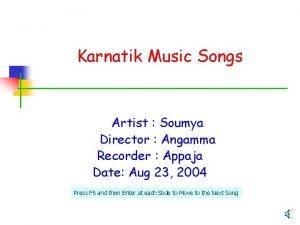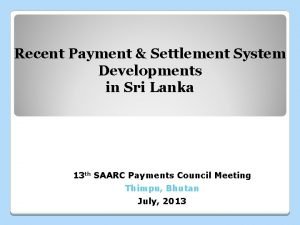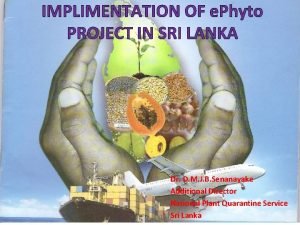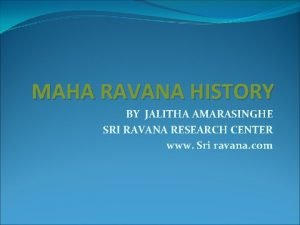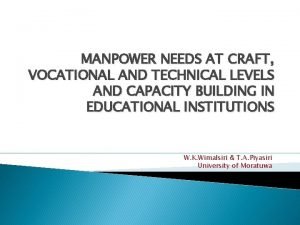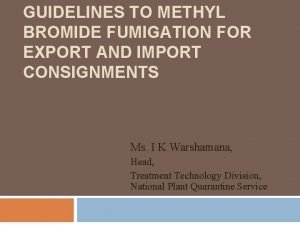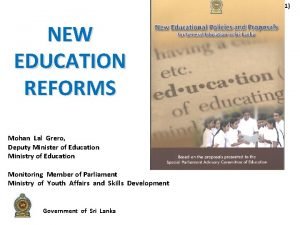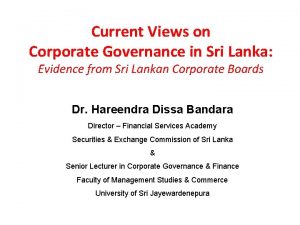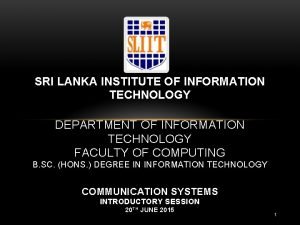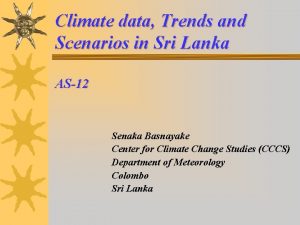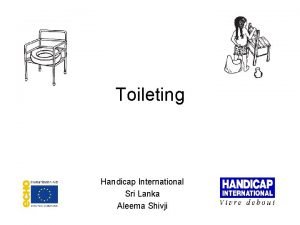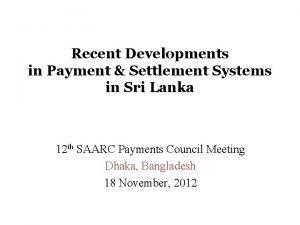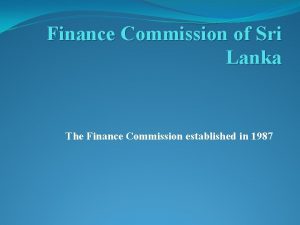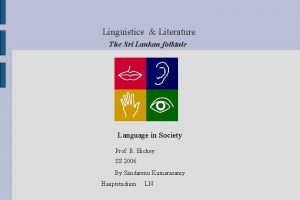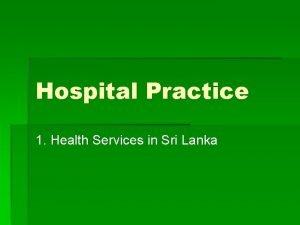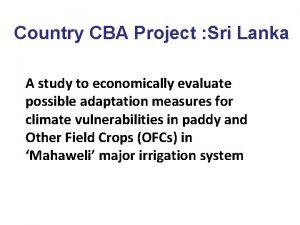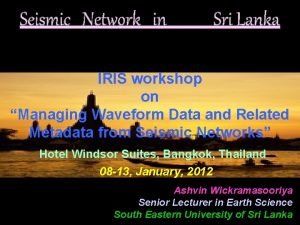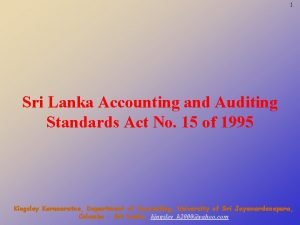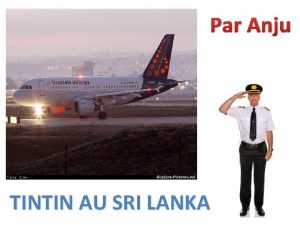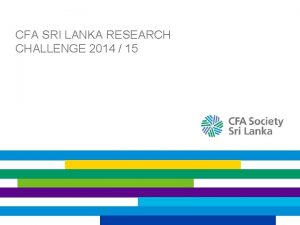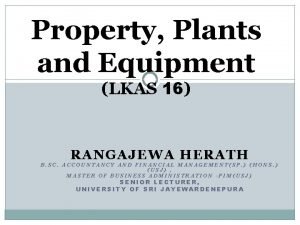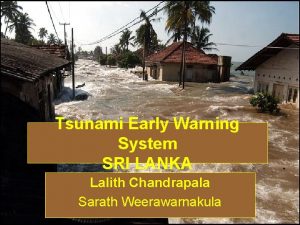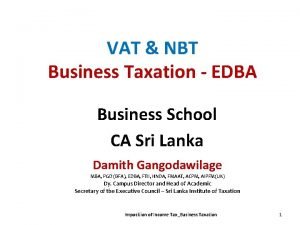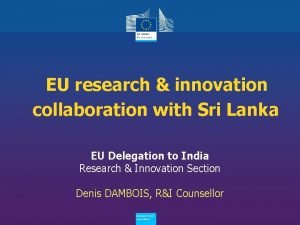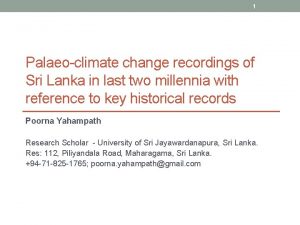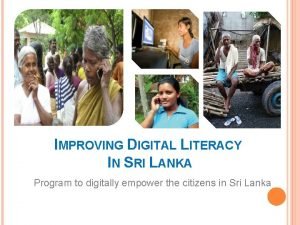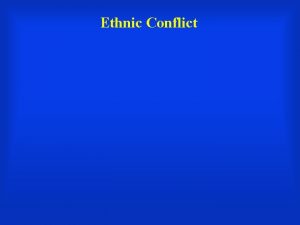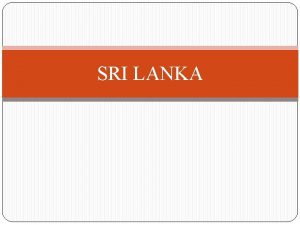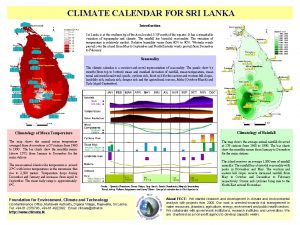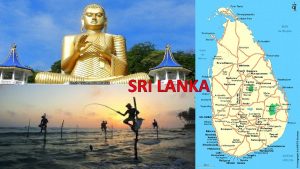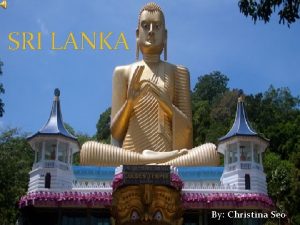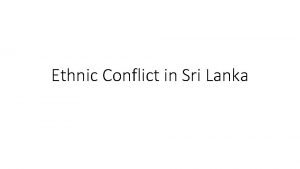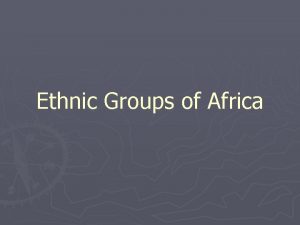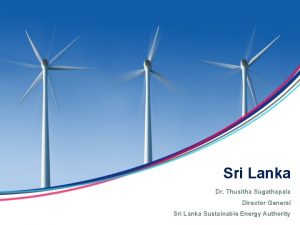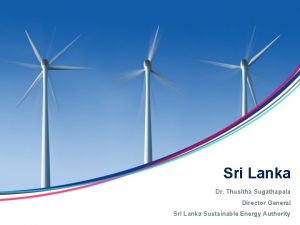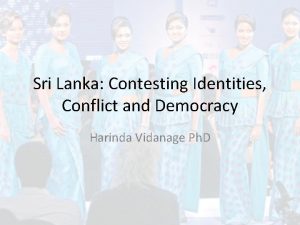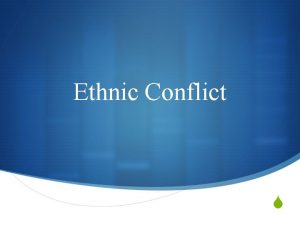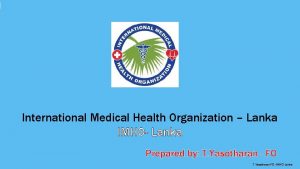Ethnic Conflict The TamilSinhalese Conflict in Sri Lanka


































- Slides: 34

Ethnic Conflict The Tamil-Sinhalese Conflict in Sri Lanka PLS 405: Ethnicity, Nationalism, and Democracy

Tamils in Sri Lanka • 6 th Amendment, Sri Lanka Constitution – “No person shall directly or indirectly, in or outside Sri Lanka, support, espouse, promote, finance, encourage or advocate the establishment of a separate State within the territory of Sri Lanka”. – Anyone who contravenes that provision becomes liable to the imposition of civic disability for up to 7 years, the forfeiture of his movable and immovable property. . . the loss of his passport. . . the right to engage in any trade or profession. . . In addition if he is a Member of parliament, he loses the seat. 2

3

4

Sri Lanka: Geography • Indian Ocean island • Size: – 65, 610 sq km • Land Use: – Around 30% of the total land is dedicated to crop cultivation 5

Sri Lanka: Population • Population: – 19, 668, 000 (2005) – Sinhalese: – Tamil: 78% 18% 6

Sri Lanka: Religion • Buddhism is dominant religion • Division: – – Buddhist: Hindu: 15% Christian: Muslim: 7% 70% 8% • Tamils are primarily Hindu • Why? 7

Sri Lanka: Language • Official Languages: – Sinhala 90% – Tamil 20% • English Proficiency: – English 10% 8

Sri Lanka: Government • Official Title: – Democratic Socialist Republic of Sri Lanka • Capital: – Colombo • President: – Mahinda Rajapakse • Prime Minister: – Ratnasiri Wickremanayake 9

A Brief History • The Sinhalese arrived in late 6 th century BCE • Tamil presence is noted throughout the country’s written history but its origins are not dated • Portuguese arrived in 1505 and took control by 1517 • Dutch took control in 1638 • Britain took control by 1796 • Independence granted in 1948 10

Majority and Minority • Many myths and legends fabricated by the “Bhikkus” to convince generations of Sinhalese that the Hindu Tamils should be considered a threat • They tried to shape Sinhalese national consciousness by deliberately exaggerating historical events 11

Majority or Minority? • Sinhalese community began to view itself as a small minority living under the shadow of grave threat posed to its identity • Tamil minority comprises two distinct groups: • Jaffna Tamils – Descendents of first tribes • Indian Tamils – Descendents of Indian indentured servants 12

Sources of Contention • Tensions rose due to Tamils having a perceived economic advantage over Sinhalese – Adoption of Sinhala as official language following independence angered Tamils – Lack of equal political opportunity • Soulbury Commission 1944 – Provided on paper protection against prejudicing of minority interests that could easily be overturned by constitutional amendment – Increase in Sinhalese Buddhist Nationalism 13

New Trouble for Tamils • PM Dudley Senanayake laid down strict requirements for citizenship that very few Indian Tamils could meet – Vast majority of Indian Tamils became suddenly stateless and the overall Tamil capacity to defend their rights was reduced – Successive governments enacted discriminatory legislation and policies and initiated programs of colonization of traditionally Tamil areas by Sinhalese peasants – Tamils felt increasingly marginalized 14

The LTTE • Why did they think that militancy was their only remaining option? – Sri Lanka is/was a democracy • The Tamil New Tigers formed – The largest and most powerful militant group was the LTTE, founded in 1972 as the Tamil New Tigers • The Tamil New Tigers joined with several other militant organizations to form the LTTE, Liberation Tigers of Tamil Eelam 15

The LTTE • As with many militancy groups, it split – In 1981, a faction broke away from the LTTE to form the People’s Liberation Organization of Tamil Eelam (PLOTE) – Rash of similar groups began appearing in the 1980 s • Why would militancy groups be prone to schisms? 16

The LTTE • Initially, the violence: – Assassination of political figures • Changed: – Eventually became a civil war • What would make it change? – The government’s stance during anti-Tamil riots of 1983 made the LTTE widen their target areas 17

Tamil Demands and Sinhalese Responses • Tamils seek political autonomy (or independence) based on their “right” to their territorial homeland (Eelam) in the north and east of the island – Belief in this right stems from the relative autonomy enjoyed prior to British rule – This claim is rejected by Sinhalese who claim: • It is their “religious-ethnic destiny” to control the entire island • The Tamils are invaders 18

Internationalization • Who does the international community support and why? – International community was generally sympathetic to Tamil cause • Military help for Sri Lanka – Received arms from several South Asian states – Counterinsurgency training from Mossad 19

Internationalization • India’s position – India’s foreign intelligence agency operated training camps in India where Tamil insurgent groups were trained in guerilla warfare and the operation of sophisticated weapons systems • Why would India not support the Sri Lankan government? 20

Indian Intervention • Peace Talks (1983) • Tamil demands: The Sri Lankan government must recognize: – The Sri Lankan Tamils as a distinct nationality – The Tamil traditional homeland in the northern and eastern provinces – The Tamil right of selfdetermination – The Sri Lankan citizenship of all Tamils on the island, including Indian Tamils 21

Indo-Sri Lankan Accord • Signed in July 1987 • Provided for: – Cessation of hostilities, – Surrender of arms by the Tamil insurgent groups – Return of the Sri Lankan military to the barracks – India guarantor of the accord – An 8000 -strong Indian peacekeeping force (IPKF) 22

Indo-Sri Lankan Accord • Problems: – No Tamil organization was a party to the accord – Insurgent groups were upset that it did not grant the right to selfdetermination – Extremist Sinhalese politicians and parts of the military were against it – IPKF was not supposed to engage in military action • Later was ordered to crack down on anyone who violated the accord • Poorly prepared for this task 23

Indo-Sri Lankan Accord • Result: – Resistance against accord grew – Revival of militant Sinhalese nationalism under the People's Revolutionary Front (JVP) • The End: – In 1990, the Indian government withdrew the IPKF 24

The Decade of the 1990 s • The departure of the IPKF led to renewed fighting in the northern and eastern provinces and a very bloody JVP insurrection in the south • In 1995, the LTTE breaks a cease-fire agreement after three months 25

The Decade of the 1990 s • The LTTE came to be seen as the main obstacle to peace by the international community • They were accused of: – Drug trafficking and arms smuggling to finance their fight – Condemned for killing civilians – Using torture – Using children and women as frontline combatants 26

Enter Norwegian • Norway gets results! – After months of talks with government officials and LTTE representatives, Norwegian facilitators reached an indefinite cease-fire agreement on February 23, 2002 27

Enter Norway • The face-to-face talks began in Thailand in September 2002 – The LTTE agreed to accept autonomy and self-governance in northeastern Sri Lanka • December 2002: – Agreement on federal political system that would allow for Tamil self-determination in Tamildominated areas 28

Suspension of Peace Talks • During the peace talks the LTTE and the Sri Lankan government continued to send contradictory signals: – The LTTE continued military buildup and started to recruit heavily and refused to rule out the option of secession – The Sri Lankan military also recruited heavily and drew up plans for a modernization of the armed forces • The LTTE abruptly suspended the peace talks in April 2003 29

Today • Skirmishes between LTTE rebels and government forces were decreasing until April 2006 – Riots broke out in the northeast and explosions killed 16 people – On 11 May 2006, the LTTE attacked a Naval convoy – The attack was seen as the most blatant violation to date of the 2002 peace agreement – On 16 October 2006, a LTTE suicide attack on a Sri Lankan naval convoy killed 93 sailors and wounded 150 others 30

Today – Peace talks ceased, and attacks by LTTE rebels and government forces have resumed 31

Current Prospects for Peace • Rajapakse entered two-day talks with the LTTE in Geneva on 28 October 2006 • The talks, which were the first in eight months, covered the humanitarian crisis in Sri Lanka – The first day of the negotiations was dominated by back-and-forth recriminations – The second failed due to disagreement on access to the Jaffna peninsula – The talks were deemed a failure 32

Current Prospects for Peace • The LTTE’s top negotiator died in late 2006 • Around the same time the government enacted legislation to increase its search and arrest powers, aimed at the LTTE • So far, more than 60, 000 people have died in the Sri Lankan conflict, over 3, 000 of those since late 2005 33

Comments? 34
 Sri rama sri rama sri manoharama
Sri rama sri rama sri manoharama Payment and settlement system in sri lanka
Payment and settlement system in sri lanka Phytosanitary certificate sri lanka
Phytosanitary certificate sri lanka Maha ravana raula
Maha ravana raula Nvq levels in sri lanka
Nvq levels in sri lanka Methyl bromide banned countries list
Methyl bromide banned countries list Www.mohanscience.lk
Www.mohanscience.lk Corporate governance in sri lanka
Corporate governance in sri lanka Food and beverage industry in sri lanka
Food and beverage industry in sri lanka Agriculture insurance in sri lanka
Agriculture insurance in sri lanka Sri lanka institute of information technology
Sri lanka institute of information technology Climate data sri lanka
Climate data sri lanka Aleema shivji
Aleema shivji Sri lanka tea board elevation average
Sri lanka tea board elevation average Lanka settle system
Lanka settle system Finance commission of sri lanka
Finance commission of sri lanka Sri lanka folk tales
Sri lanka folk tales Administrative structure of health service in sri lanka
Administrative structure of health service in sri lanka Condominium act sri lanka
Condominium act sri lanka Cba sri lanka
Cba sri lanka Seismometer in sri lanka
Seismometer in sri lanka Sri lanka auditing standards in sinhala
Sri lanka auditing standards in sinhala Tintin in sri lanka
Tintin in sri lanka Sachille atapattu
Sachille atapattu Shotokan karate sri lanka
Shotokan karate sri lanka Lkas 16 presentation
Lkas 16 presentation Labai. lk
Labai. lk Sri lanka tsunami warning system
Sri lanka tsunami warning system One inch map of sri lanka
One inch map of sri lanka Nbt tax
Nbt tax Collab sri lanka
Collab sri lanka Physical quality of life index and human development index
Physical quality of life index and human development index Pathra dathuwa
Pathra dathuwa Digital literacy in sri lanka
Digital literacy in sri lanka English worksheet for grade 11 pdf
English worksheet for grade 11 pdf
